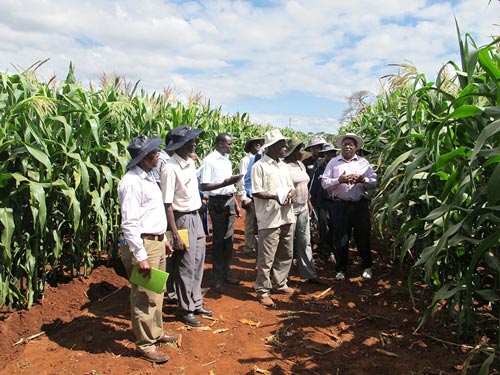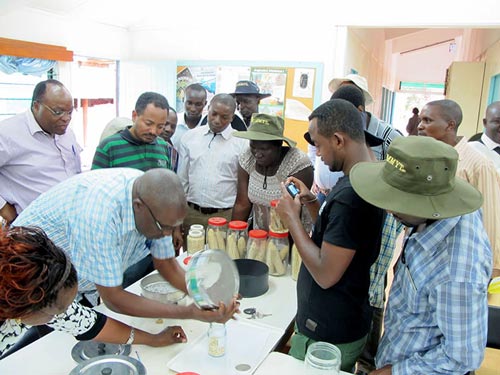 “The trip was an eye opener for me. We have no mass rearing facility in Ethiopia; neither do we practice artificial infestation of stem borers. We only undertake natural infestation for our trials, which does not give uniform infestation, leading us to wrong conclusions,” said Midekssa Ardessa from Bako Agricultural Research Center at the Ethiopian Institute of Agricultural Research (EIAR), who visited CIMMYT-Kenya during 21-27 July 2013 with a team of scientists from Ethiopia, Uganda, Tanzania, and Mozambique, to gain hands-on experience in breeding insect-resistant maize. “We are now very knowledgeable on mass rearing of stem borers and on running an insectary after our visit and practical sessions at the CIMMYT Katumani Insectary,” added Abiy Dibaba from EIAR’s Melkasa Agricultural Research Center. “At the CIMMYT Kiboko Postharvest Lab, we learned a lot about maize weevils and the larger grain borer, and how to screen maize for resistance against these postharvest pests.”
“The trip was an eye opener for me. We have no mass rearing facility in Ethiopia; neither do we practice artificial infestation of stem borers. We only undertake natural infestation for our trials, which does not give uniform infestation, leading us to wrong conclusions,” said Midekssa Ardessa from Bako Agricultural Research Center at the Ethiopian Institute of Agricultural Research (EIAR), who visited CIMMYT-Kenya during 21-27 July 2013 with a team of scientists from Ethiopia, Uganda, Tanzania, and Mozambique, to gain hands-on experience in breeding insect-resistant maize. “We are now very knowledgeable on mass rearing of stem borers and on running an insectary after our visit and practical sessions at the CIMMYT Katumani Insectary,” added Abiy Dibaba from EIAR’s Melkasa Agricultural Research Center. “At the CIMMYT Kiboko Postharvest Lab, we learned a lot about maize weevils and the larger grain borer, and how to screen maize for resistance against these postharvest pests.”
The visit, organized and facilitated by the Insect Resistant Maize for Africa (IRMA III Conventional) and the Water Efficient Maize for Africa (WEMA) projects, aimed to build capacity in maize breeding for insect resistance using conventional approaches, insect resistance screening, and management of field and lab infestations. Participants came from EIAR; Kenya Agricultural Research Institute (KARI); Selian Agricultural Research Institute (SARI), Tanzania; National Biological Control Program, Tanzania; Ministry of Agriculture, Tanzania; National Crops Resources Research Institute (NACRRI) of the National Agricultural Research Organization (NARO), Uganda; and National Institute of Agronomic Research (IIAM), Mozambique.
“The visit provided an opportunity for the scientists to understand IRMA’s and WEMA’s research work in Kenya and a forum to share experiences in mass rearing, breeding, and pest control among participating countries,” said Stephen Mugo, CIMMYT principal scientist/maize breeder and IRMA and WEMA projects coordinator. It is also a learning process for CIMMYT scientists, he added. The team visited CIMMYT insect pests resistant germplasm nurseries and trials at the Embu, Kirinyaga University College, and Kiboko sites where they learned how to set up, infest, manage, and take data on stem borer trials and nurseries. At the KARI-Katumani IRMA III Conventional collaborative stem borer mass rearing facilities, participants learned to set up, equip, and manage stem borer mass rearing; in Kiboko they focused on the set up, management, and data collection for storage pests screening. The field and lab practical sessions were facilitated by CIMMYT scientist/entomologist Tadele Tefera.
 The annual IRMA project’s program has trained more than 50 scientists since its inception in 2009. “Most of us talk very easily and confidently about insect rearing. However, it is quite a challenge when we engage in the practical aspects,” said Tefera. “What we have exposed you to is just a tip of the iceberg in the business of mass rearing of insects. There is still a lot to learn, much of it by yourself as you engage in the practical aspects of it.” The participants appreciated the effort taken by the organizers. One of them, Egas Nhamucho of IIAM, said: “Infestation of maize with stem borers was a real learning point for me, a real delicate task of picking out very tiny 10 insect larvae, ensuring that you do not pierce and kill them with the camel brush, and carefully and strategically placing them on each maize plant. The practical sessions really made me appreciate some of the tasks we have always taken for granted.”
The annual IRMA project’s program has trained more than 50 scientists since its inception in 2009. “Most of us talk very easily and confidently about insect rearing. However, it is quite a challenge when we engage in the practical aspects,” said Tefera. “What we have exposed you to is just a tip of the iceberg in the business of mass rearing of insects. There is still a lot to learn, much of it by yourself as you engage in the practical aspects of it.” The participants appreciated the effort taken by the organizers. One of them, Egas Nhamucho of IIAM, said: “Infestation of maize with stem borers was a real learning point for me, a real delicate task of picking out very tiny 10 insect larvae, ensuring that you do not pierce and kill them with the camel brush, and carefully and strategically placing them on each maize plant. The practical sessions really made me appreciate some of the tasks we have always taken for granted.”
Concluding the event, CIMMYT scientist/maize breeder Yoseph Beyene called on the participating scientists to ensure that as many people as possible get access to the knowledge they gained. “Invest in people to effectively and successfully undertake your research,” he said.
WEMA project manager Sylvester Oikeh thanked CIMMYT scientists for the support they provided to the Ugandan team in setting up the Namulonge Insectary. “I am looking forward to other countries emulating Uganda and setting up their insectaries,” Oikeh added.
 Capacity development
Capacity development 
